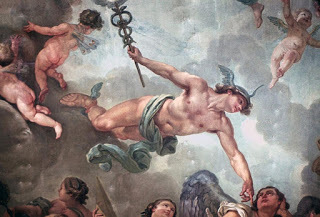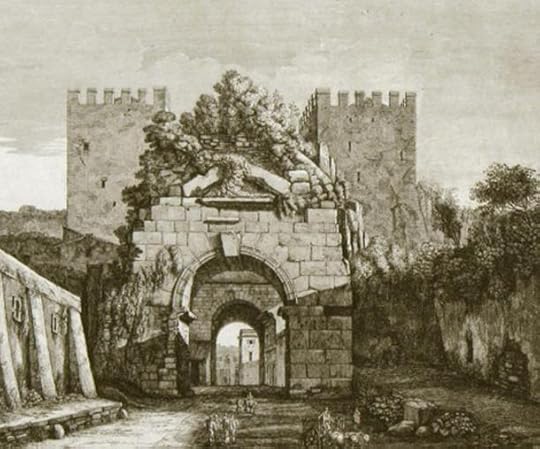Two thousand year old Mercury figurine found in Yorkshire
 Ancient Origins
Ancient OriginsA metal detector enthusiast has discovered a 2000-year old figurine depicting the Roman god Mercury in a field near Selby, Yorkshire, UK.
It is the 1,000th officially recorded archaeological find of the year so far in Yorkshire. The artifact was registered by Dave Cooper of the York and District Metal Detecting Club on May 15th, ironically the date of the Roman festival that once honored the god himself.
Rebecca Griffiths, the Finds Liaison Officer for the Portable Antiquities Scheme at the York Museums Trust told Culture24 said that the registration of the artifact on the day of the ancient Mercuralia was “pure coincidence – but a very happy one.”
 Rebecca Griffiths of York Museums Trust with the copper alloy figurine of Mercury. Photographs: Richard McDougallThe Mercuralia, or ‘Festival of Mercury’ honoured the Roman god of messengers, who was known as Hermes to the Greeks. There are separate Roman myths concerning Mercury which do not have any equivalents in Greek myth, however in both cultures the god was believed to be a god of traders and commerce. The Roman name ‘Mercury’ is related to the latin words merx, mercari and merces, meaning merchandise, trade and wages respectively. May 15th was also believed to be Mercury’s birthday, also called the ‘Ides of May’. Merchants in Rome celebrated the festival by sprinkling their merchandise, ships and their heads with water from a fountain at Porta Capena called the ‘aqua Mercurii’. They carried the water in laurel boughs and prayed to the god for forgiveness, profit and the ability to cheat on customers.
Rebecca Griffiths of York Museums Trust with the copper alloy figurine of Mercury. Photographs: Richard McDougallThe Mercuralia, or ‘Festival of Mercury’ honoured the Roman god of messengers, who was known as Hermes to the Greeks. There are separate Roman myths concerning Mercury which do not have any equivalents in Greek myth, however in both cultures the god was believed to be a god of traders and commerce. The Roman name ‘Mercury’ is related to the latin words merx, mercari and merces, meaning merchandise, trade and wages respectively. May 15th was also believed to be Mercury’s birthday, also called the ‘Ides of May’. Merchants in Rome celebrated the festival by sprinkling their merchandise, ships and their heads with water from a fountain at Porta Capena called the ‘aqua Mercurii’. They carried the water in laurel boughs and prayed to the god for forgiveness, profit and the ability to cheat on customers.The translation of the Gallic faith into the Roman pantheon The Celtic Goddess Epona that Rode Swiftly Across the Ancient Roman Empire Ancient Roman Curse Tablets Invoke Goddess Sulis Minerva to Kill and Maim The Porta Capena was a gateway in the Servian Wall on the south side of Rome. Its stones were supposed to have been stained green by water leaking from the Aqua Marcia aqueduct that towered above it. Samuel Ball Platner mentions the fountain in his 1911 book The Topography and Monuments of Ancient Rome in which he writes:
Aqua Mercurii…a spring which is thought to be one of those now flowing in the gardens of the villa Mattei Its waters were conducted in an artificial channel through the valley of the Circus Maximus to the Cloaca Maxima
 The Porta Carpena, Rome. Copperplate engraving by Luigi Rossini (oldimprints.com)According to Rome: An Oxford Archaeological Guide by Amanda Claridge, Judith Toms and Tony Cubberley, the source of the aqua Mercurii was a small wood in which there was a sacred grove dedicated to the goddess Egeria. Mercury himself was venerated in a temple on the Aventine Hill. Although he is usually depicted as wearing a winged cap or winged sandals and carrying a caduceus, attributes borrowed from Hermes, he is also represented as carrying a purse, the symbol of the merchants he protected.
The Porta Carpena, Rome. Copperplate engraving by Luigi Rossini (oldimprints.com)According to Rome: An Oxford Archaeological Guide by Amanda Claridge, Judith Toms and Tony Cubberley, the source of the aqua Mercurii was a small wood in which there was a sacred grove dedicated to the goddess Egeria. Mercury himself was venerated in a temple on the Aventine Hill. Although he is usually depicted as wearing a winged cap or winged sandals and carrying a caduceus, attributes borrowed from Hermes, he is also represented as carrying a purse, the symbol of the merchants he protected. Statue of Mercury by Charles Meynier. Mercury is depicted wearing a winged cap and is carrying the caduceus in one hand and a purse in the other. (
Wikimedia Commons
)Mercury’s Greek counterpart, Hermes, was believed to be the son of Zeus, the king of the gods, and his queen, Maia. He was believed to be swift on his feet, thereby being able to move quickly between the worlds of gods and men. Both Hermes and Mercury were believed to be protectors of thieves and athletes, as well as of merchants. Hermes also performed the role of escorting the souls of the dying to the underworld and the afterlife. The Greeks believed that when Hermes was young, he jumped from his crib and went off to steal the cattle kept by the sun-god, Apollo, who appeared before Zeus and complained. However, Zeus simply laughed in his face. Hermes apologised to Apollo by giving him the lyre he had just made.
Statue of Mercury by Charles Meynier. Mercury is depicted wearing a winged cap and is carrying the caduceus in one hand and a purse in the other. (
Wikimedia Commons
)Mercury’s Greek counterpart, Hermes, was believed to be the son of Zeus, the king of the gods, and his queen, Maia. He was believed to be swift on his feet, thereby being able to move quickly between the worlds of gods and men. Both Hermes and Mercury were believed to be protectors of thieves and athletes, as well as of merchants. Hermes also performed the role of escorting the souls of the dying to the underworld and the afterlife. The Greeks believed that when Hermes was young, he jumped from his crib and went off to steal the cattle kept by the sun-god, Apollo, who appeared before Zeus and complained. However, Zeus simply laughed in his face. Hermes apologised to Apollo by giving him the lyre he had just made.Hermes appears in a number of Greek myths, including that of the hero Odysseus, the Odyssey. Hermes commanded the hero to chew the leaves of a magic herb so that he could avoid the gaze of Circe which had turned Odysseus’s companions into animals. The god also appears in the story of Pandora in which he gave her the ability to lie and seduce men.
 Hermes / Mercury carrying away Pandora by Jean Alaux (
Wikimedia Commons
)The Mercury figurine found in Yorkshire is made of copper alloy. Although it depicts the god wearing a cap, this garment has lost its famous wings. It is just one of many similar figures that have been found across the UK, according to the Yorkshire Post.
Hermes / Mercury carrying away Pandora by Jean Alaux (
Wikimedia Commons
)The Mercury figurine found in Yorkshire is made of copper alloy. Although it depicts the god wearing a cap, this garment has lost its famous wings. It is just one of many similar figures that have been found across the UK, according to the Yorkshire Post.The York Museums Trust regularly receives artifacts found by the general public. Such items have previously included the Bedale Hoard, the Escrick Ring and the boar badge of Richard III.
“Every year thousands of archaeological objects are discovered,” says Rebecca Griffiths. “While the majority of these come from metal-detector users, we also see many finds from people field-walking, gardening, renovating houses and even those out walking particularly inquisitive dogs.”
Ms Griffiths added that every year, she and her team of volunteers add more than 2,000 items to the museum’s collection, ranging from Roman coins to medieval buckles, to stone tools and post-medieval toys.
Featured image: ‘The Elevation of the Great Elector into Olympus’. Ceiling painting (detail: Mercury), City Palace, Potsdam ( Wikimedia Commons ).
Published on June 05, 2015 06:24
No comments have been added yet.



